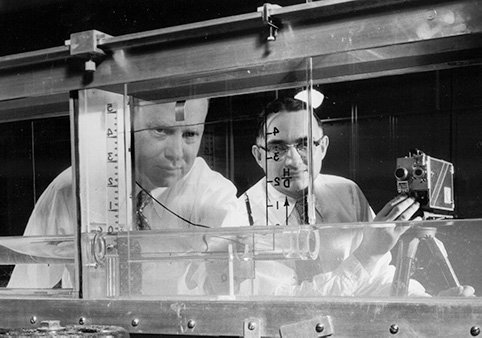A Legacy of SAFL Leadership

SAFL has a unique and distinguished historic legacy, largely defined by the vision of its top leadership. Dr. Lorenz G. Straub, Professor of Civil Engineering, is considered the mastermind for making the idea of a hydraulic laboratory at the University of Minnesota and the St. Anthony Falls into a reality. Serving as the primary architect, Straub oversaw the construction of the laboratory using Works Progress Administration (WPA) funding from 1936 -1938. Serving as SAFL's director for the following two decades, Straub was associated with some of the world's largest water resource and hydroelectric developments, and he brought several of those projects to SAFL as model studies. He also had a longstanding relationship with the U.S. Army Corps of Engineers, serving as a special consultant on various river problems, and made numerous contributions to the professional literature in both basic and applied areas.
In the period 1963-1977, and under the leadership of Directors Edward Silberman and Alvin Anderson, SAFL aimed to intensifythe already robust naval hydrodynamics research and at expanding its basic research in such areas as stratified flows, turbulence, and hydrology. The expansion to these new research areas was made possible by funding from the National Science Foundation (NSF).
From 1977 through 1993 under the direction of Roger Arndt, SAFL emphasized the integration of education and basic and applied (service to the profession) research. Research in hydraulic and river engineering continued. Several new faculty were appointed, bringing new research efforts in computational fluid dynamics; water resources and energy; environmental and water quality research; naval hydrodynamics, hydroacoustics, aeroacoustics, and cavitation; wind engineering research; small hydropower development; space-time rainfall modeling; and geomorphology. Funding for these efforts was provided from such diverse agencies as the U.S. Navy, NSF, National Aeronautics and Space Administration (NASA), the U.S. Department of Energy, Air Force Office of Scientific Research, Hamburg Ship Model Basin (Germany), and the Legislative Commission for Minnesota Resources.
In the period of 1993-2005, Directors Gary Parker and Efi Foufoula-Georgiou emphasized broadening the participation of other University of Minnesota researchers at SAFL and adding new faculty who brought expertise in the areas of geology, eco-biological fluid dynamics, and atmospheric boundary layer turbulence. Research expanded further to include environmental fluid mechanics, water quality, hydrometerorology, biochemistry, fluvial geomorphology, sedimentology, and atmospheric transport using a unique combination of experimental, computational, and theoretical approaches. The new research areas and faculty expertise catalyzed the transformation of SAFL from the traditional hydraulic engineering research facility to a hub of progressive interdisciplinary fluid mechanics research. These efforts culminated in 2002 by the establishment of the National Center in Earth-surface Dynamics (NCED), a NSF Science and Technology Center, at SAFL. Over the next 11 years, NCED helped established SAFL as a preeminent research center in the Earth-surface dynamics community, generating resources that fueled many areas of laboratory growth.
From 2006-2015, under the leadership of Director Fotis Sotiropoulos, SAFL continued its expansion into new interdisciplinary research areas, emphasizing renewable energy resources (wind, marine hydrokinetic energy, and biofuels), environmental restoration, and biological and cardiovascular fluid mechanics. The SAFL-led University of Minnesota Eolos wind energy research consortium, which brought together academic partners, industry, and government laboratories, was established in 2009 and funded by an ARRA grant from the U.S. Department of Energy. This consortium led to the development of a major new research facility in Rosemount, MN, where the 2.5MW Eolos wind energy research field station was installed. Sotiropoulos also oversaw the first major renovation in SAFL's history, leading the charge in securing an ARI-R2 grant from NSF and the University of Minnesota to restore and replace aging infrastructure and updating SAFL's experimental facilities.
Today, newly renovated, with the foundation of almost 80 years of research excellence, education, and collaboration, SAFL stands poised to help tackle some of society's greatest environmental challenges. We are excited to welcome our next director and continue contributing to the success of the University of Minnesota, the College of Science and Engineering, the state, and society through fundamental research, research training, and outreach.
